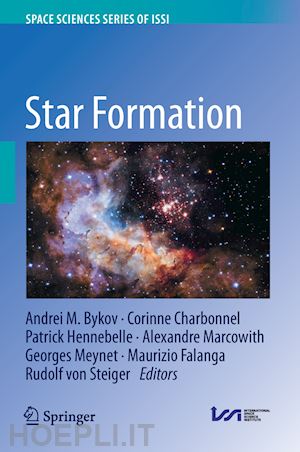
Questo prodotto usufruisce delle SPEDIZIONI GRATIS
selezionando l'opzione Corriere Veloce in fase di ordine.
Pagabile anche con Carta della cultura giovani e del merito, 18App Bonus Cultura e Carta del Docente
Editorial.- Physical processes in Star Formation.- The molecular cloud lifecycle.- From diffuse gas to dense molecular cloud cores.- The origin of the stellar mass distribution and multiplicity.- Zooming in on Individual Star Formation: Low- and High-mass Stars.- Star clusters near and far; tracing star formation across cosmic time.- The Physics of Star Cluster Formation and Evolution.- Formation and Evolution of Disks around Young Stellar Objects.- Formation of the first stars and black holes.- Impact of low-energy cosmic rays on star formation.- High-energy particles and radiation in star-forming regions.
Corinne Charbonnel is professor of Astrophysics at the University of Geneva (Switzerland) and Senior Researcher at CNRS (France). She was the President of the French Society of Astronomy and Astrophysics (SF2A) and of Division G (Stars and Stellar Physics) of the International Astronomical Union (IAU). She has pioneered studies of the impact of magnetohydrodynamical mechanisms on the transport of angular momentum and of chemicals in stellar interiors. She studies the broad consequences of these processes on stellar evolution and nucleosynthesis, planet habitability, stellar population properties across cosmic time, and the chemical and dynamical evolution of star clusters and galaxies.
Patrick Hennebelle is an expert of the star formation process and the dynamics of the interstellar medium. He performs heavy numerical simulations that he confronts on one hand to analytical models and on the other hand to observations. He has particularly been working on the formation of molecular clouds, the collapse of dense cores, the formation of planet-forming discs and the origin of the stellar initial mass function.
Alexandre Marcowith is staff researcher in the high-energy astrophysics department at Montpellier university. His research is centred on the physics and Astrophysics of Cosmic Rays focusing on acceleration and transport processes in the inter-stellar medium. He is member of the High Energy Stereoscopic System (HESS) and Cerenkov Telescope Array (CTA) collaboration.
Maurizio Falanga received his university degree for Theoretical Physics and Astronomy at the University of Basel, Switzerland and his PhD degree in astrophysics from the University of Rome "La Sapienza”, Italy. He received the venia docendi in physics from the University of Basel in 2013. His scientific background is in high-energy astrophysics (hot universe and compact objects). Since 2009 he is the Science Program Manager at the International Space Science Institute (ISSI) in Bern, Switzerland. Between 2013 and 2019 he has been appointed as the first Executive Director of the International Space Sciences Institute in Beijing, China. He is author and co-author of about 200 published papers and editors of several books in his research fields.
Rudolf von Steiger holds a diploma (MS) in theoretical physics (1984), a doctorate (PhD) in experimental physics (1988), and a habilitation in extraterrestrial physics (1995) from the University of Bern. He was a co-investigator of the Solar Wind Ion Composition Experiment (SWICS) on Ulysses and an associated scientist of the AMPTE and ACE missions. His relevant experience includes theoretical modelling of solar chromospheric processes, specifically of the FIP fractionation effect, as well as the analysis and interpretation of solar wind observations both in the Earth's magnetosheath and in interplanetary space. In 1995 he joined the newly created International Space Science Institute (ISSI) in Bern as a senior scientist. Currently he is working as a director at the ISSI and also holds an associate professorship at the University of Bern, both since 1999. He has received an early career award from the Swiss National Science Foundation and holds several achievement awards from both NASA and ESA. He currently serves as an editor for Space Science Reviews, Frontiers in Space Physics, and Living Reviews in Solar Physics.











Il sito utilizza cookie ed altri strumenti di tracciamento che raccolgono informazioni dal dispositivo dell’utente. Oltre ai cookie tecnici ed analitici aggregati, strettamente necessari per il funzionamento di questo sito web, previo consenso dell’utente possono essere installati cookie di profilazione e marketing e cookie dei social media. Cliccando su “Accetto tutti i cookie” saranno attivate tutte le categorie di cookie. Per accettare solo deterninate categorie di cookie, cliccare invece su “Impostazioni cookie”. Chiudendo il banner o continuando a navigare saranno installati solo cookie tecnici. Per maggiori dettagli, consultare la Cookie Policy.